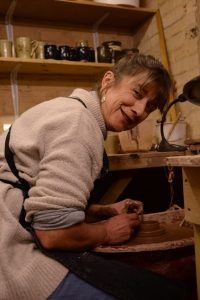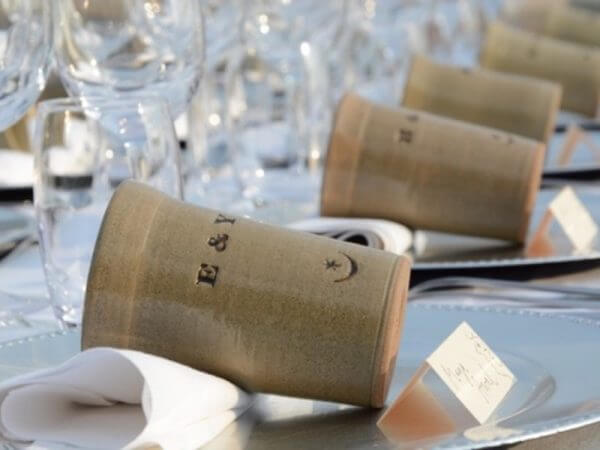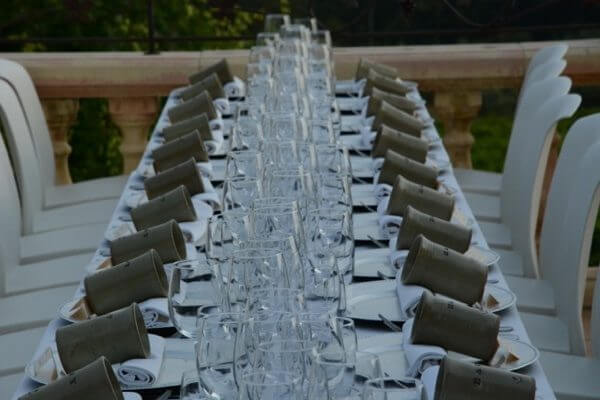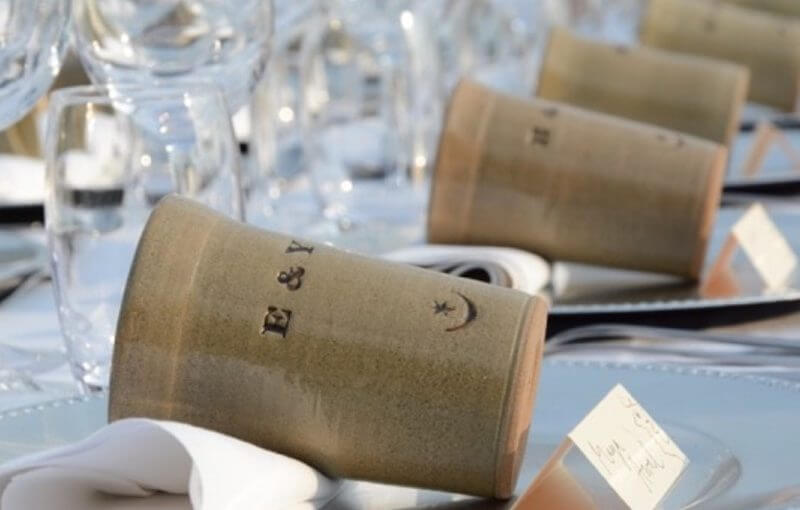“The pottery is my refuge.”
By Kate Charlton-Jones, WTP Guest Writer
There is intense joy and anticipation in opening a kiln that’s been firing and then cooling for twenty-four hours or more: you never know quite what you will find. Have all the pots made it through, without cracks and blemishes? How have the glazes behaved? Are the colours what you expected? Holding a beaker or jug, a plate or a bowl, fresh and still warm from the kiln, is restorative. Moments before, my heart rate increased as I had stepped forward to open that door. Now I am holding something useful, hopefully beautiful, and I have made it. My mind and breathing slowly calm. This is an experience that never diminishes in intensity. Only a matter of days ago, what I am holding had been mud.
I discovered my love for ceramics in my thirties. I had been a very bookish child and had pursued a straightforward education into teaching without ever really discovering a creative gene within me. I’d read and written copiously as a teenager and, yes, of course, both these activities are artistic and imaginative, but I hadn’t physically made anything as both my education and my home life spurred me on to jump over higher and higher academic hurdles. The focus required to be high-achieving was itself a form of consolation for the gathering chaos around me. My parents had an unhappy marriage, which was stretched to breaking point by my father’s infidelities and constant absences. It’s hard not to see my mother’s death when she was forty-nine as a consequence of the turbulence and pain she experienced bringing up four children in Warwickshire without much emotional support. It was easier for me to bury myself in Jane Austen or George Eliot than to make sense of the lies and false reassurances I experienced daily. It sounds very pompous, but if you’re searching for truth—and who isn’t—words on a page seem far more stable than disingenuous words, always uttered in an attempt to conceal what is actually happening. I say this in order to explain my delight in mud. There’s an honesty about it.

In my thirties, newly married and living in Japan where my husband’s work had taken us, I discovered not just an appreciation for ceramics, but an opportunity to learn. The class was in Japanese, so my learning was limited by more poor language skills, but I watched intensely and I listened as best I could. The basics were cemented and I had a skill for throwing. What I didn’t realize until much later was that I had found a tool for living.
When Virginia Woolf wrote about a room of one’s own in 1929, she meant a refuge: quiet, ordered, and conducive to thought. She didn’t have in mind a cold, draughty former garage full of tools and clay. The pottery is my refuge. In there, it’s just me, my lump of clay, and my creative thoughts. I pound it and wedge it, to get rid of the air, and as I do so, I’m thinking about its weight, its plasticity, and its viscosity. I’m also asking myself questions. What will I make? Do I need more or less clay? Is the surface I’m working on absolutely clear of dust or specks of hard clay that will infect this piece of mud? That, of course, is a question I should have asked earlier, and I probably did, but nevertheless I stop to check again.
Then I’m in the groove and I wedge some more. By now, I know what I’m going to make and I measure out perhaps a dozen balls of clay all exactly the same weight, with a wire, cutting lumps from my wedged mound, adding and subtracting little bits to get the weight exact, and then placing them carefully in a clean bowl before covering them with a sheet of clean plastic. I say clean twice, but nothing is ever really clean in a pottery studio. Dust is part of the furniture of the place. Potters are constantly washing their hands, sweeping or Hoovering their floor and wiping down surfaces, but it is never clean.
With the clay weighed and ready to go, I start to get excited about the “throwing.” This is the act of creating something on a wheel and the part I love the most. Taking one of the pieces of soft (but not sticky) clay from under the plastic, I pat it into a round ball, turning it over and over in my hands. I’m not just shaping the clay as I do this but am also ensuring every part of my hands is fully awake. Then I throw the rounded lump down hard onto the center of the wheel. It never actually hits the very center but I aim for that. It’s time to set the wheel in motion. Gently pressing down with my right foot on a wooden lever, the wheel-head turns, not too fast but at a steady speed so that there is controlled, not frantic, momentum. I slosh water over the clay and, while my left hand is pushing towards the right, my right hand is steering the clay towards the center, pushing in the opposite direction and sliding over the cone that is forming. More water, and then with the heel of my right hand, I push down and slightly towards the left. It may sound strange but my whole body is engaged in the task.
While my thinking is now all in my hands, my body relaxes, giving in to the creative process. Yet more water is needed as I flatten the now-centered clay to a particular width: a large pot needs a wide base; a small one, a narrower base. Then, with my right index finger, I press down on the center of the mound, stopping about two centimeters before I hit the wheel head. The same finger, joined now by the middle finger of my right hand, pulls sideways towards the right to create a base for the vessel. At this point, I usually reach for a wooden tool with a flat end and gently press it into the base, removing excess clay and the grooves made by my fingertips. I take a soft sponge on a stick and push into the puddle of water forming in the base; this soaks up the water and allows me to see what’s happening. Potters need a lot of water but need it on the sides of the pot, not pooling in the base, so the act of soaking up water and splashing water over the sides is oft repeated.
Having successfully formed the base, and cleared out the excess water, I am now ready to pull up the sides and make a cylinder. From this point on, all my thinking is in my fingertips; they are alive to any ridge or bump and are leading the process. Everything that has happened since the wheel started to turn has perhaps been the work of a couple of minutes or even less, but it has required concentration and the experience of many failures to make it a seamless act.
Being “in the moment” is something of a goal for all of us. We’re told to practice this through mindfulness or yoga, running or swimming, singing or painting. It’s good for our mental health, good for our sense of understanding of self, and we’ll be better for it. I’m absolutely sure that this is true. However, finding the way or several ways to find the right interest for ourselves can be a difficult journey. My younger sister found it in tapestry; my younger son in meditation and drumming. It turns out that making pots is what cleanses my mind and helps release my anxieties. As I work, alone, often cold and always filthy, I’m unconsciously or consciously working through troubles that otherwise cloud my thinking. I don’t want to stretch the metaphor to a breaking point, but perhaps as I pummel the clay, I’m beating my anxieties into some kind of submission. And as a jogger finds a rhythm pounding the pavements, I find a rhythm in preparing the clay, and then another one as I work on the wheel. It’s the rhythm that propels you forward and it’s in that forward motion that creativity happens and a calmness, even happiness, is possible.

The healing effects of my pottery were brought home to me in the spring. After a routine mammogram, I was diagnosed with breast cancer and within two weeks, had a mastectomy. Of course, this was a huge shock, but I took it well and tried to take it in my stride. Of all the cancers one might get, breast cancer seemed minor compared to what others were going through. My children and husband were incredible, as were our wonderful friends, so I was very lucky to have a great deal of support to carry me forward. Not needing chemotherapy, I was able to look ahead without fear of constant sickness. Nevertheless, it was a difficult time and I disliked being a patient, disliked even more sitting around resting. As soon as I could move my right arm without pain, I was in my studio. I had a contract to fulfill. I had promised my son and now daughter-in-law that I would make two hundred ceramic beakers for their July wedding in France and, come hell or high water, I was going to honor that promise.
Prior to my diagnosis at the end of March, I had only made about forty of these wedding “favors.” Each one was hand-thrown and stamped with the initials of the bride and groom and the date of the ceremony. After the first firing, the lettering had to be carefully picked out in iron oxide, the beaker then dipped in glaze and fired for a second time, before it could be termed a useful artefact. I think I must have made about 260 beakers in total—you lose a lot in pottery to bad throwing, or shoddy glazing, or breakages—and each beaker had been handled many, many times. By the end of July, there they all were, laid out in a glorious array.

Long before the wedding itself, I became aware of the positive effects of the challenge I’d set myself. I wasn’t dwelling on cancer but thinking about lettering, or whether I had enough clay or about when I’d be able to fit in making more glaze, and there was of course, the constant pressure of time passing—a weekend away could feel like a grievance. I wanted and needed to pot. There is no doubt that this sounds obsessional. It was, but it was a healthy obsession propelling me forwards and away from morbid thoughts. I was contributing something positive toward the wedding, and the wedding, through my pottery, was helping me. Perfect synchronicity.
All images by Finn Charlton-Jones
Kate Charlton-Jones spent her childhood in rural Warwickshire before going up to Cambridge in 1978 where she studied English Literature at New Hall College. In her twenties, she taught English at a High School in London. After five years, and now married, she moved to Japan, where she began studying pottery. Kate returned to England in 1991 with her husband and two small children and in 1996 she had her third child. For twenty years, the children were the main focus of her life but she did manage to complete a PhD in 2010, and in 2014 her book Dismembering the American Dream: the Life and Fiction of Richard Yates was published by the University of Alabama Press. By 2015, Kate was back in her studio and hasn’t left it since. Her pots are available on etsy.com under Priory Pots.

